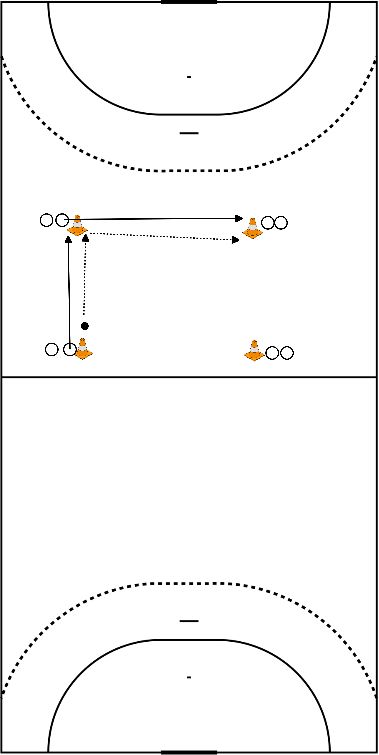Handball drills
- Blue with black starts with and runs 3 passes with the ball
- Throws the ball to red who comes running in
- Red throws the ball again to the next blue player who comes running in
- This is how the circle goes around
More difficult:
- 1 defender in the middle
- 2 defenders and 1 circle player
- Blue plays to red and red plays to the circle player
- Circle player plays to blue again
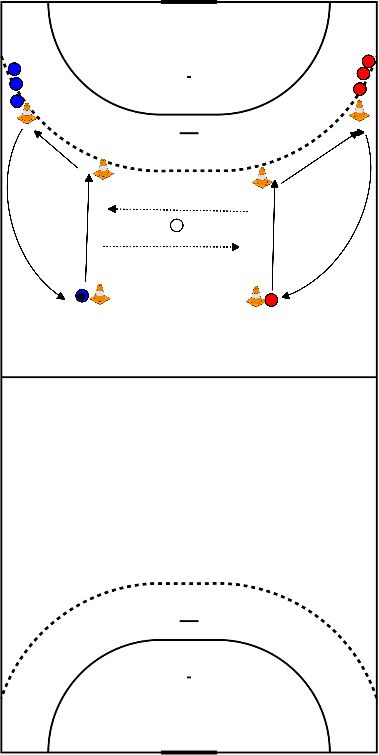
- 4 pawns
- At each pawn 1 player without ball
- The rest run between the four pawns with ball
The players in the middle try to play to the players in the corner.
Attention:
- Corners actively ready
- Eye contact
- Being active in the middle (No rows)
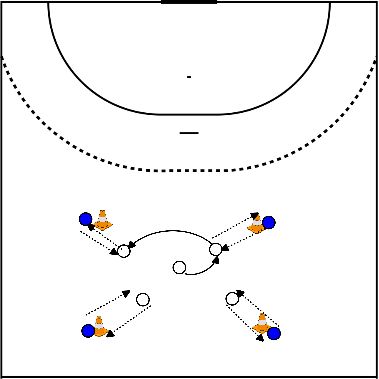
- Place 2 pylons in the middle of the field.
- Put 2 blue defenders in them.
- Let the rest of the team try to get across between the pylons.
- The "red attackers" may only make 1 attempt to get past them.
- Try to make it clear to the defenders that they have a better chance if they work together.
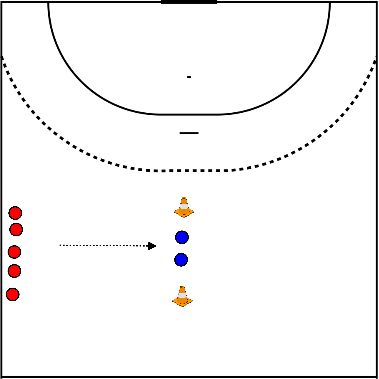
There are players who make only 1 or 2 passes when making a jump shot. To practice to really make 3 passes, you can do this exercise:
- Put 4 benches in a row as shown in the drawing.
- Have them take turns on the 1st bench.
- Then make 3 passes across the benches.
- Take a jump shot.
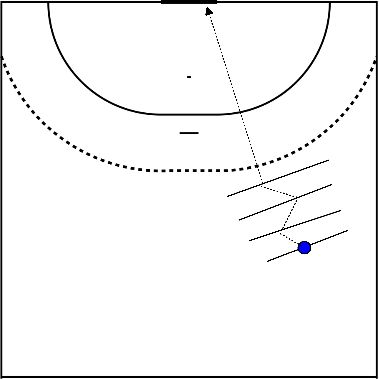
The team runs in a run around the half court.
- Player 1 has the ball and holds the ball behind his head.
- Player 2 tries to grab the ball and then does the same to player 3.
- And so on.
As soon as the one behind has the ball she/he takes a sprint forward so that she/he becomes player 1 and then it starts again.
- Player 1 has the ball and runs backwards and throws the ball with a bounce to player 2.
- The latter turns around and throws the ball to player 3.
- And so on.
As soon as the back has the ball he takes a sprint forward so that he becomes player 1 and then it starts again.
- Make pairs of 2 of approximately the same strength/weight
- Place your hand on each other's shoulders and/or upper arm
- After the whistle, try to push your opponent over a predetermined line
- The one who gets the opponent over the line first wins
- After a few times you switch opponents
- Jump shot explanation:
- Left - right - left - outlet with left for jump - shoot in the air. Left-handed players do it the other way around.
- Eventually you should be able to start it with both legs.
- Pay attention to height - so don't just jump forward. Use arms and 1 leg to get extra upward energy. First in slow motion!
- Trainer stands halfway up 9 meters
- Players line up at a distance
- Player throws ball to trainer, runs in, catches ball at the 9 meter and finishes with 3 passes- jump shot
- Trainer is on knees gets ball from player, player makes jump shot and throws over trainer.
- Mark floor with hats for null pass, catch and down, and jump shot with 1 or 3 passes.
- 2 rows of players at 11 meters
- dribble and jump on run shot
- hands
- left/right high
- left/right low
- ground
- Limited space at the circle.
- 1 v 1.
- Try to get past the defender, moving quickly and turning away. Possibly pass and feint movement.
- Explain what is and is not allowed in terms of defense.
- Hands against shoulders. Not from the side.
- Do not hold arms.
- Do not obstruct a broken player.
In F use a small goal.
- Divide the group into two teams.
- The teams stand side by side with about five meters between the players.
- The players of each team stand behind each other, thus forming a line.
- The course of the game is a square.
- Team 1 starts in the far left corner of the square and team 2 starts at the same height in the far right corner of the square.
- Thus, the two teams stand horizontally on the same line.
- At the beginning of the game, the first two players from each team will compete against each other.
Game:
- At the coach's whistle, these 2 players begin to run and follow the lines of the square.
- They will run until they meet on their way.
- At that point they will have to fight for passage!
- This is how you do it:
- You play leaf-stone-scissors.
- Both players hold hands behind their backs and count down together: " 1 , 2 , 3 " and after 3 they each show a symbol:
- leaf: the hand outstretched
- stone: the hand clenched into a fist
- scissors: index finger and middle finger extended
- The leaf overcomes the stone, the stone overcomes the scissors and the scissors win on the leaf.
- Of course, when the same symbol is shown, you have to start counting again.
- The player who wins the leaf-stone-scissors game may continue walking along the lines of the square.
- The loser walks back.
- The goal is to get to the other team as quickly as possible!
- But: when someone loses, the next player from that losing team starts walking until he meets his opponent again.
- Then the leaf-stone-scissors game begins again.
- Thus, the winning player is always stopped until he/she reaches his/her team.
- Divide the group into 2 teams.
- Make an F-Field; width of field.
- Have the groups pass the ball 10x to each other without the other team touching the ball for 1 point. Pass only, do not bounce.
- With an odd group, you can give one player a different vest and they will always play on the team with possession of the ball.
Making it more difficult:
- Do not pass to the same back.
- Everyone must take their turn.
- Ball must not touch the ground.
- Only pass with a bounce.
- You plot a square with the desired distance to fit.
- Each corner has a pawn.
- 1 ball is needed.
- One player starts and throws the ball clockwise to the next corner. Then runs to the next corner chasing the ball.
- This is how the square goes around.
Possible challenges:
- Throwing clockwise and running counterclockwise.
- With 2 balls.
- With 2 balls throwing diagonally and crossing. Beware of other players.
- With bounce.
- With connecting passes to the next corner.
